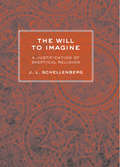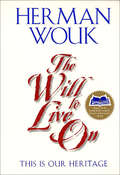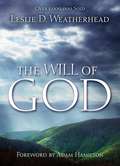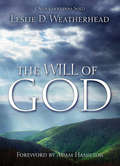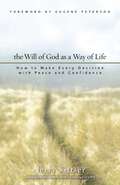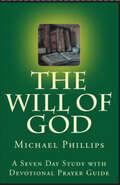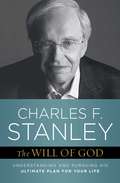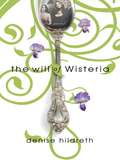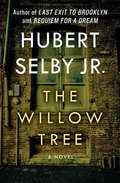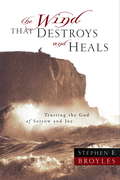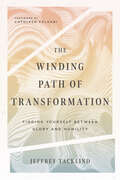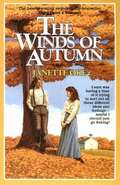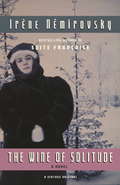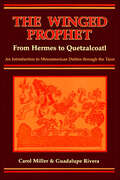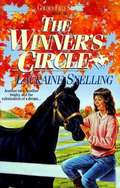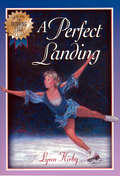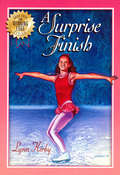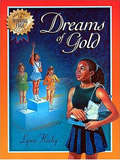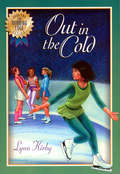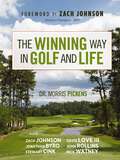- Table View
- List View
The Will To Imagine: A Justification of Skeptical Religion
by J. L. SchellenbergThe Will to Imagine completes J. L. Schellenberg's trilogy in the philosophy of religion, following his acclaimed Prolegomena to a Philosophy of Religion and The Wisdom to Doubt. This book marks a striking reversal in our understanding of the possibility of religious faith. Where other works treat religious skepticism as a dead end, The Will to Imagine argues that skepticism is the only point from which a proper beginning in religious inquiry-and in religion itself-can be made. For Schellenberg, our immaturity as a species not only makes justified religious belief impossible but also provides the appropriate context for a type of faith response grounded in imagination rather than belief, directed not to theism but to ultimism, the heart of religion. This new and nonbelieving form of faith, he demonstrates, is quite capable of nourishing an authentic religious life while allowing for inquiry into ways of refining the generic idea that shapes its commitments. A singular feature of Schellenberg's book is his claim, developed in detail, that unsuccessful believers' arguments can successfully be recast as arguments for imaginative faith. Out of the rational failure of traditional forms of religious belief, The Will to Imagine fashions an unconventional form of religion better fitted, Schellenberg argues, to the human species as it exists today and as we may hope it will evolve.
The Will To Live On: This is Our Heritage
by Herman WoukHerman Wouk has ranged in his novels from the mighty narrative of The Caine Mutiny and the warm, intimate humor of Marjorie Morningstar to the global panorama of The Winds of War and War and Remembrance. All these powers merge in this major new work of nonfiction, The Will to Live On, an illuminating account of the worldwide revolution that has been sweeping over Jewry, set against a swiftly reviewed background of history, tradition, and sacred literature.Forty years ago, in his modern classic This Is My God, Herman Wouk stated the case for his religious beliefs and conduct. His aim in that work and in The Will to Live On has been to break through the crust of prejudice, to reawaken clearheaded thought about the magnificent Jewish patrimony, and to convey a message of hope for Jewish survival.Although the Torah and the Talmud are timeless, the twentieth century has brought earthquake shocks to the Jews: the apocalyptic experience of the Holocaust, the reborn Jewish state, the precarious American diaspora, and deepening religious schisms. After a lifetime of study, Herman Wouk examines the changes affecting the Jewish world, especially the troubled wonder of Israel, and the remarkable, though dwindling, American Jewry. The book is peppered with wonderful stories of the author's encounters with such luminaries as Ben Gurion, Isidor Rabi, Yitzhak Rabin, Saul Bellow, and Richard Feynan.Learned in general culture, warmly tolerant of other beliefs, this noted author expresses his own other beliefs, this noted author expresses his own faith with a passion that gives the book its fire and does so in the clear, engaging style that--as in all Wouk's fiction--makes the reader want to know what the next page will bring.
The Will of God
by Leslie D. WeatherheadThe Will of God by Leslie D. Weatherhead is a classic in Christian theology. It addresses the issue of understanding the will of God in a way that is accessible to all.
The Will of God (Festival Bks.)
by Leslie D. WeatherheadDuring the tumultuous era of World War II, the city of London shattered under unrelenting bombs dropped by Nazi Germany. Millions of buildings were destroyed or damaged, tens of thousands of civilians were killed, and survivors were left to ask: How can this destruction be part of God’s plan? What is God’s will in all of this?After City Temple in London was reduced to rubble, Rev. Leslie Weatherhead crafted five sermons on understanding the will of God to help his congregation endure religious doubt as their city—and church—crumbled around them. Weatherhead’s sermons were eventually published as The Will of God, a resource that has sold more than a million copies and has been a lifeline for grieving persons seeking to understand God’s purpose for their pain. This revised edition of the classic book includes background information and photos of the historical setting that inspired this book, and a new cover and layout to refresh a timeless message—both for new readers and returning fans.
The Will of God as a Way of Life: How to Make Every Decision with Peace and Confidence
by Jerry L. SittserPractical help for understanding and following God’s will for your life “God has a plan for our lives,” but what does that mean in practical terms? How do we know God’s will for important life decisions, like who to marry, what job to take, what church to join? How can we be free if God has a perfect plan for us? Does suffering mean we are off track? How exactly does God speak? Author Jerry Sittser explores these questions and offers a biblically based approach that is truly liberating. No matter what decisions we’ve already made, he points out that it is still possible to live out God’s perfect will—even if we think we’ve married the wrong person, chosen the wrong career, or landed in some kind of serious trouble. This new edition includes study questions designed to help individuals or groups who are faced with decisions—large or small.
The Will of God: A Seven Day Study with Devotional Prayer Guide (The\seven Day Study Ser.)
by Michael PhillipsThe author of Make Me Like Jesus shares a personal and thought-provoking inquiry into the practical mechanics of knowing God’s will in our lives.One of the greatest mysteries of the Christian faith is how we can understand the Will of God. The difficulty is underscored by Scripture’s repeated use of the word “unknowable” in connection with “the Almighty”. How can we possibly grasp that which is unknowable?Yet God commands us to know him. He also commands us to search diligently to find wisdom. We are therefore called upon to make the attempt to understand something we will never be capable of knowing. In Will of God, Michael Phillips discusses how we can best approach this challenge with gusto as well as humility.
The Will of God: Understanding and Pursuing His Ultimate Plan for Your Life
by Charles F. StanleyWhat is God’s will for your life, and how can you be sure you’re following it? Trusted pastor and bestselling author Dr. Charles Stanley helps you discover God’s purpose in this practical, insightful guide to hearing His voice.We hear so much about God’s great purposes for our lives and how they are preferable to our own, but what exactly does that mean? Does the Lord really care about the course we take? Is His path really better than what we can figure out on our own? And if so, how do we discover what He desires regarding the decisions and challenges we face every day—especially when the road ahead appears so confusing? God’s will for you doesn’t have to remain a mystery. In fact, your heavenly Father wants to reveal the plans He has for your life. In this book, Dr. Charles Stanley, beloved pastor and respected Bible teacher, teaches you how to discern what it is, see the different ways God communicates His plans, shares wisdom on how to know you’re really hearing Him, and gives specific steps to walking in God’s will for your life. The One who saves you is worthy to lead you. And whether you’re facing a major life decision, planning for the future, or simply trying to walk with the Lord day by day, The Will of God can help you draw you closer to God and discover His awesome plan for your life.
The Will of Wisteria
by Denise HildrethFour headstrong siblings must satisfy their father's dying demands--or risk losing his fortune. Let the clash of wills begin. Charleston blue blood Clayton Wilcott "got religion" late in life; so late, it turns out his kids never took to it. So he's left a provisional will delivered in a highly unorthodox way.Now they're going to have to honor Daddy's commandments from beyond the grave--for a full year--or be cut off from their substantial inheritances.The scent of wisteria lingers in the air as the four spoiled Wilcotts battle for their birthright. Told in Denise Hildreth's trademark blend of humor and heart, this Southern tale is about learning to love, learning to live, and learning to bend.
The Willow Tree: A Novel
by Hubert Selby Jr.Hubert Selby Jr., acclaimed author of the classic novel Last Exit to Brooklyn, tells the powerful story of an extraordinary bond between an African-American teen seeking vengeance in the wake of tragedy and an old man who guides him toward redemptionGrowing up in New York City&’s soul-killing South Bronx ghetto, Bobby, a young black teenager, has only known violence, poverty, and despair. But there is one true light in his life: his girlfriend, Maria. On their way to school one morning, they are set upon by a vicious street gang. Bobby, beaten bloody and senseless, survives, rescued by an old German man who is himself a survivor of the Nazi death camps. The man calls himself Moishe, though he claims not to be Jewish, and he takes the damaged boy under his wing, determined to help heal his physical and psychological wounds. An unlikely friendship is born, strengthened by a shared sense of loss and life&’s tragic injustices. But Moishe&’s message of learning to forgive the unforgivable falls on deaf ears, because there is a hole in Bobby&’s heart that only revenge can fill. Hubert Selby Jr.&’s extraordinary novel is a devastating work of raw power and stylistic brilliance that captures the pain and hardship of twentieth-century urban life. Unflinching and unrelenting, in the vein of his acclaimed masterwork, Last Exit to Brooklyn, Selby&’s The Willow Tree is a dark tale tempered by hope: a story of love, death, rage, violence, and salvation. This ebook features an illustrated biography of Hubert Selby Jr. including rare photos from the author&’s estate.
The Wind that Destroys and Heal: Trusting the God of Sorrow and Joy
by Stephen E. BroylesWhy would a loving, all-powerful God allow so much pain and suffering? It’s a question everyone asks–from skeptics to spiritual seekers to confirmed believers. InThe Wind That Destroys and Heals,theologian and educator Stephen Broyles wrestles with it personally, powerfully, and poignantly. After enduring the horror of his young wife’s death, Broyles interrogated the Scriptures to find a reasonable explanation for his devastating loss. In this book he supplies the coordinates readers need to track God through the darkest, most broken stretches of life. God is there in all of it, and it’s possible for us to locate him even when the thickening darkness dims our sight. Like the psalmists of the Hebrew Scriptures, Broyles challenged God to explain himself, to demonstrate why in heaven’s name any sane person should trust God. And he received an answer–though not the one he expected: God is a Wind that could easily destroy us but who also holds out the only promise for our healing. We understand our undoing only in light of who God is. And we find our ultimate healing only in God.
The Winding Path of Transformation: Finding Yourself Between Glory and Humility
by Jeff TacklindMost books on church leadership today emphasize techniques for growth, success, and brand-building. But Jeff Tacklind, pastor of Church by the Sea—a quirky, diverse congregation in Laguna Beach, California—knows from decades of ministry experience that sometimes effective leadership looks like standing in the middle of conflict, holding the tension. In The Winding Path of Transformation, Tacklind describes spiritual transformation as an invitation to paradox. By entering into suffering, he says, we find joy. By embracing the downward path of humility, we find glory. And by remaining small, sometimes we grow to great heights. Any leaders who have wondered if God really called them to lead a congregation will resonate with Tacklind's vulnerability in this honest and meditative account. So will readers who have found their own spiritual journey to be winding and halting rather than a constant ascent of growth. Tacklind draws from the natural world—trees, waves, mountains, and canyons—to bring to life the lessons that he has picked up along the way. C. S. Lewis, Henri Nouwen, Søren Kierkegaard and others all serve as guides who light the way on the winding path of following God.
The Winds of Autumn (Seasons of the Heart #2)
by Janette Okea young man's Faith is put to the test when a teacher with strange ideas comes to town, bringing his pretty daughter. A story about the bonds of family and the strength of faith and good friends.
The Winds of Catawba
by Laurie StahlSince leaving England, Laurel has struggled to maintain the reputation of a lady in order to win a gentleman husband--Jason Portland. But she has found that her love for adventure does not befit a "proper" lady. When Jason arrives from England, Laurel begins to see through his blond good looks and genteel manner to the cruel and abusive person beneath the facade. Then Joshua Douglas moves in next door and begins to spend time with Laurel--but he will not open up to her, or expose the heartaches of his past.... Meanwhile, Kendra is madly in love with Court Yardley, an indentured servant at Catawba. When his period of service is over, they plan to marry. But Court sees Joshua at Catawba so often that he misinterprets his presence as love for Kendra. So Court breaks off their engagement to give Kendra to a man more "Worthy" of her.... Can Laurel, Kendra, and the others at Catawba find the love, faith and guidance from the Lord they so desperately need?
The Winds of Sonoma (Regalo Grande Series, #1)
by Nikki AranaAngelica Amante, a New York lawyer, faces the most important choice of her career. Should she side with her firm and sanction the exploitation of illegal immigrants or stand against injustice? When she meets Antonio Perez, son of a poverty-stricken Mexican family, her compassion for the poor grows. Will she follow her ambition---or her heart?
The Wine of Solitude
by Sandra Smith Irene NemirovskyIntrospective and poignant, The Wine of Solitude is the most autobiographical of all of the novels from the celebrated author of Suite Française. Beginning in a fictionalized Kiev, The Wine of Solitude follows the Karol family through the Great War and the Russian Revolution, as the young Hélène grows from a dreamy, unhappy child into a strongwilled young woman. From the hot Kiev summers to the cruel winters of St Petersburg and eventually to springtime in Paris, the would-be writer Hélène blossoms, despite her mother's neglect, into a clear-eyed observer of the life around her. Here is a powerful tale of disillusionment -- the story of an upbringing that produces a young woman as hard as a diamond, prepared to wreak a shattering revenge on her mother.A Vintage Paperback Original
The Winged Prophet: From Hermes to Quetzalcoatl
by Carol Miller Guadalupe RiveraThe Winged Prophet from Hermes to Quetzalcoatl, provides the first ever introduction to the deities of MesoAmerica as they relate to classical European mythology and the archetypes contained in the major arcana of the tarot cards.
The Wings to Awakening: An Anthology from the Pali Canon
by Thanissaro BhikkhuThis anthology is organized around the set of Buddhist teachings that Buddha said formed the heart of his message: the Wings to Awakening (bodhi-pakkhiya-dhamma).
The Winner's Circle (Golden Filly #10)
by Lauraine SnellingAs she and her filly Firefly recover from a tragic racing accident, Trish tries to find out who is behind the disturbing threats she continues to receive. She also discovers that God has a perfect plan for her life.
The Winning Edge Series: A Perfect Landing
by Lynn KirbyFor Amy Pederson, nothing is more important than reaching her goal of becoming a top figure skater. But just as things are looking promising, Amy's father is disabled in an accident and her family is forced to move to Texas to be near her grandparents. What follows is a story filled with encouragement and a growing faith in God who Amy doesn't yet know. The book ends with Amy accepting Christ with the support of her new found friend, Kristen.
The Winning Edge Series: A Surprise Finish
by Lynn KirbyKristen Grant has everything it takes to be a champion skater: talent, dedication, and proper training. In addition, she has the support of a strong Christian family. After years of hard work, Kristen is close to achieving her dream. She has just won first place in a regional championship when her father makes a surprise announcement. After returning from a recent mission trip, Mr. Grant asks the family to consider more involvement in missions, perhaps even moving overseas. Kristen is torn: she really wants to obey God, but how can she give up skating, especially now.
The Winning Edge Series: Dreams of Gold
by Lynn KirbyJamie Summers is a talented young African-American skater who dreams of winning national and world championships. Her role model is Brianna Hill, an African-American skater who recently won the national title. Jamie is determined to do whatever it takes to be just like Brianna, no matter what the cost. However, when Jamie has the chance to meet the champion in person, she begins to realize that Christ is the only real role model.
The Winning Edge Series: Out In The Cold
by Lynn KirbyShannon didn't start skating until age twelve, but she is making up for lost time. The trouble is, her parents don't seem to realize how important skating is to her. To make matters worse, her best friends (Amy and Kristen) are preparing for a major competition for advanced skaters. Shannon's efforts to keep up with her friends land her in serious trouble! Only then does she learn to trust God with her problems.
The Winning Summer (Keystone Stables)
by Marsha HublerOnce a rebellious juvenile delinquent, thirteen-year-old Skye now finds herself in a position to help others when her foster parents open the stables to a group of kids who have big problems just like she did. Skye finds her faith and patience tested as she, Chad, and Morgan teach horseback riding to four special needs children, including Katie, who is blind. Upset about her parents' pending divorce, Katie is withdrawn and bitter at God and the world. With faith and friendship, Skye tries her best to show an increasingly isolated Katie that her parents-and God-will always love her, no matter what. Will Skye's efforts be good enough?
The Winning Way in Golf and Life
by Morris PickensGolf tips and spiritual testimonials from some of the best players in the game today! In The Winning Way in Golf and Life, nationally recognized sports psychologist Dr. Morris (Mo) Pickens provides his in-depth formula for winning "one shot at a time" and living life "one moment at a time." Pages are filled with behind-the-scene stories, full-color photography, and Scriptural insights from top PGA players such as Zach Johnson, Stewart Cink, Jonathan Byrd, Nick Watney, Davis Love III, and John Rollins. The book will not only enhance your game, but it will change your life. Features & Benefits:Makes a meaningful gift for golfers any time of yearInspires golfers to improve their game on and off the courseGreat gift for Father's DayFeatures insights from sports psychologist Dr. Morris Pickens
The Winnowing Season: Book Two in the Amish Vines and Orchards Series (Amish Vines and Orchards #2)
by Cindy WoodsmallThe tornado that devastated Kings' Orchard pushed Rhoda, Samuel, and Jacob to make a new start in Maine. Are they strong enough to withstand the challenges of establishing an Amish community--and brave enough to face the secrets that move with them? On the eve of their departure to begin a new Old Order Amish community outside of Unity, Maine, Rhoda Byler is shocked to discover that choices made by her business partner and friend, Samuel King, have placed her and her unusual gifts directly into the path of her district's bishop and preachers. She is furious with Samuel and is fearful that the Kings will be influenced by the way her leaders see her, and not what they know to be true--that Rhoda's intuition is a gift from God. Jacob King won't be swayed by community speculation. He loves Rhoda, believes in her, and wants to build a future with her in Maine. But when the ghosts of his past come calling and require him to fulfill a great debt, can he shake their hold before it destroys what he has with Rhoda? Samuel has a secret of his own--one he'll go to great lengths to keep hidden, even if it means alienating those closest to him. Throwing himself into rehabilitating the once-abandoned orchard, Samuel turns to a surprising new ally. Book 2 of the Amish Vines and Orchards series asks: can the three faithfully follow God's leading and build a new home and orchard in Maine? Or will this new beginning lead to more ruin and heartbreak?
